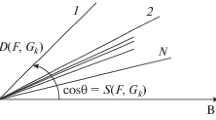Abstract
At the present time, the methods for the measurement and prediction of the dynamic strength of materials are complicated and unstandardized. An experimental data processing method based on the incubation time criterion is considered. Only a finite number of measurements containing random errors and limited statistical information are usually available in practice, since dynamic tests are laborious, and every individual test requires a lot of time. This strongly restricts the number of applicable data processing methods unless we are satisfied with approximate and heuristic solutions. The method of sign-perturbed sums (SPS) is used for the estimation of finite-sample confidence regions with a specified confidence probability under the assumption of noise symmetries. It is shown that several experimental points are sufficient to determine the strength parameter with an accuracy acceptable for engineering calculations. The applicability of the proposed method is demonstrated in the processing of a number of experiments on the dynamic fracture of rocks.
Similar content being viewed by others
References
J. D. Campbell and W. G. Ferguson, “The temperature and strain-rate dependence of shear strength of mild steel,” Philos. Mag. 21, 63–82 (1970).
A. J. Rosakis, J. Duffy, and L. B. Freund, “The determination of dynamic fracture toughness of alsi 4340 steel by the shadow spot method,” J. Mech. Phys. Solids 32, 443–460 (1984).
D. A. Shockey, L. Seaman, and D. R. Curran, Material Behavior under High Stress and Ultrahigh Loading Rates (Springer-Verlag, New York, 1983).
G. R. Johnson and W. H. Cook, “Fracture characteristics of three metals subjected to various strains, strain rates, temperatures and pressures,” Eng. Fract. Mech. 21, 31–48 (1985).
V. S. Nikiforovsky and E. I. Shemyakin, Dynamic Fracture of Solids (Nauka, Novosibirsk, 1979) [in Russian].
K. Ravi-Chandar, “Experimental challenges in the investigation of dynamic fracture of brittle materials,” in Physical Aspects of Fracture (Kluwer, Dordrecht, 2001), in Ser.: NATO Science Series, Series II: Mathematics, Physics and Chemistry, Vol. 32, pp. 323–342.
J. F. Kalthoff and S. Winkler, “Failure mode transition at high rates of shear loading,” in Proc. Int. Conf. on Impact Loading and Dynamic Behavior of Materials, Bremen, 1987 (DGM-Informationsgesellschaft, Oberursel, 1988), pp. 161–176.
G. I. Kanel, S. V. Razorenov, K. Baumung, and J. Singer, “Dynamic yield and tensile strength of aluminum single crystals at temperatures up to the melting point,” J. Appl. Phys. 90, 136–143 (2001).
Y. V. Petrov and A. A. Utkin, “Dependence of the dynamic strength on loading rate,” Mater. Sci. 25, 153–156 (1989).
Y. V. Petrov, “Incubation time criterion and the pulsed strength of continua: Fracture, cavitation, and electrical breakdown,” Dokl. Phys. 49, 246–249 (2004).
A. A. Gruzdkov and Y. V. Petrov, “Cavitation breakup of low-and high-viscosity liquids,” Tech. Phys. 53, 291–295 (2008).
N. M. Pugno, “Dynamic quantized fracture mechanics,” Int. J. Fracture 140, 159–168 (2006).
Q. Z. Wang, S. Zhang, and H. P. Xie, “Rock dynamic fracture toughness tested with holed-cracked flattened Brazilian discs diametrically impacted by SHPB and its size effect,” Exp. Mech. 50, 877–885 (2010).
L. Ljung, System Identification: Theory for the User (Prentice Hall, Englewood Cliffs, NJ, 1999).
E.-W. Bai, K. M. Nagpal, and R. Tempo, “Bounded-error parameter estimation: Noise models and recursive algorithms,” Automatica 32, 985–999 (1996).
F. Blanchini and M. Sznaier, “A convex optimization approach to synthesizing bounded complexity HINF filters,” IEEE Trans. Autom. Control 57, 219–224 (2012).
B. Csaji, M. C. Campi, and E. Weyer, “Sign-perturbed sums: A new system identification approach for constructing exact non-asymptotic confidence regions in linear regression models,” IEEE Trans. Signal Process. 63, 169–181 (2015).
S. H. Cho, Y. Ogata, and K. Kaneko, “Strain-rate dependency of the dynamic tensile strength of rock,” Int. J. Rock Mech. Min. Sci. 40, 763–777 (2003).
M. Volkova, G. Volkov, O. Granichin, and Y. Petrov, “Sign-perturbed sums approach for data treatment of dynamic fracture tests,” in Proc. 56th IEEE Conf. on Decision and Control (CDC), Melbourne, Australia, Dec. 12–15, 2017 (IEEE, Piscataway, NJ, 2018), pp. 1652–1656. ## http://ieeexplore.ieee.org/document/8263887/
A. Senov, K. Amelin, N. Amelina, and O. Granichin, “Exact confidence regions for linear regression parameter under external arbitrary noise,” in Proc. 2014 American Control Conference (ACC 2014), Portland, OR, June 4–6, 2014 (IEEE, Piscataway, NJ, 2014), pp. 5097–5102.
A. A. Senov and O. N. Granichin, “Identification of linear regression parameters for arbitrary external noise in observations,” in Proc. 12th All-Russ. Meeting on Control Problems (VSPU-2014), Moscow, June 16–19, 2014 (Inst. Probl. Upr. im. V.A. Trapeznikova, Moscow, 2014), pp. 2708–2719.
K. Amelin and O. N. Granichin, “Randomized control strategies under arbitrary external noise,” IEEE Trans. Autom. Control 61, 1328–1333 (2016).
Author information
Authors and Affiliations
Corresponding author
Additional information
Original Russian Text © M.V. Volkova, O.N. Granichin, G.A. Volkov, Yu.V. Petrov, 2018, published in Vestnik Sankt-Peterburgskogo Universiteta: Matematika, Mekhanika, Astronomiya, 2018, Vol. 63, No. 1, pp. 30–40.
About this article
Cite this article
Volkova, M.V., Granichin, O.N., Volkov, G.A. et al. On the Possibility of Using the Method of Sign-Perturbed Sums for the Processing of Dynamic Test Data. Vestnik St.Petersb. Univ.Math. 51, 23–30 (2018). https://doi.org/10.3103/S1063454118010132
Received:
Accepted:
Published:
Issue Date:
DOI: https://doi.org/10.3103/S1063454118010132



